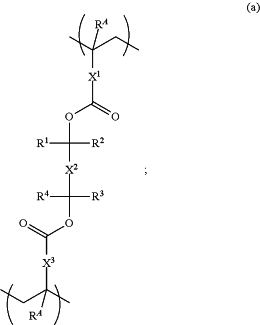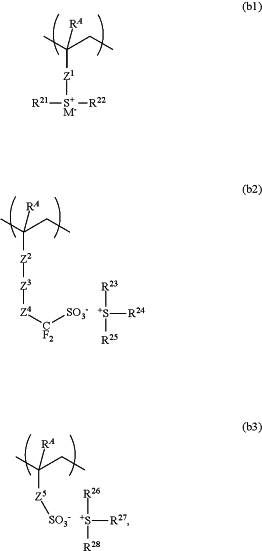| CPC G03F 7/0397 (2013.01) [G03F 7/0045 (2013.01); G03F 7/2006 (2013.01)] | 10 Claims |
|
1. A positive resist material comprising a base polymer comprising:
a repeating unit comprising two carboxyl groups whose hydrogen atoms are substituted with two tertiary carbon atoms each bonded to a double bond or triple bond, shown by the following formula (a):
 and
a repeating unit having an acid generator, shown by any of the following formulae (b1) to (b3):
 wherein:
RA's are identical to or different from one another and each represent a hydrogen atom or a methyl group;
X1 represents a single bond, or a linking group having 1 to 12 carbon atoms containing at least one selected from the group consisting of an ester bond, an ether bond, and a lactone ring;
X2 represents a vinylene group or an ethynylene group;
X3 represents a single bond, a phenylene group, or a linking group having 1 to 12 carbon atoms containing at least one selected from the group consisting of an ester bond, an ether bond, and a lactone ring;
R1 to R4 each represent a linear, branched, or cyclic alkyl group having 1 to 8 carbon atoms;
Z1 represents a single bond, a phenylene group, —Z11—, —O—Z11—, —C(═O)—O—Z11—, or —C(═O)—NH—Z11—;
each Z11 represents an aliphatic hydrocarbylene group having 1 to 6 carbon atoms, a phenylene group, a naphthylene group, or a group having 7 to 18 carbon atoms obtained from a combination thereof, and optionally contains a carbonyl group, an ester bond, an ether bond, or a hydroxy group in a carbon chain of Z11;
Z2 represents a single bond, a phenylene group, or an ester bond;
Z3 represents a single bond, —Z31—C(═O)—O—, —Z31—O—, or —Z31—O—C(═O)—;
each Z31 represents a divalent hydrocarbon group having 1 to 12 carbon atoms, and optionally contains a carbonyl group, an ester bond, an ether bond, a bromine atom, or an iodine atom;
Z4 represents a methylene group, a 2,2,2-trifluoro-1,1-ethanediyl group, or a carbonyl group;
Z5 represents a single bond, a methylene group, an ethylene group, a phenylene group, a fluorinated phenylene group, —O—Z51—, —C(═O)—O—Z51— or —C(═O)—NH—Z51—;
each Z51 represents an alkanediyl group having 1 to 12 carbon atoms, an alkenediyl group having 2 to 12 carbon atoms, a phenylene group, a fluorinated phenylene group, or a trifluoromethyl group-substituted phenylene group, and optionally contains a carbonyl group, an ester bond, an ether bond, or a hydroxy group;
R21 to R28 each independently represent a hydrocarbyl group having 1 to 20 carbon atoms optionally containing a fluorine atom, a chlorine atom, a bromine atom, an iodine atom, or a heteroatom;
R23 and R24, or R26 and R27, are optionally bonded to each other to form a ring together with a sulfur atom bonded thereto; and
M− represents a non-nucleophilic counter ion.
|